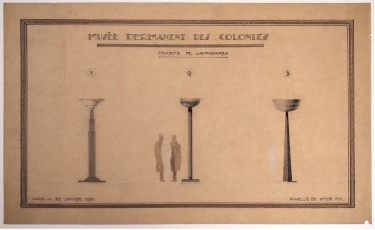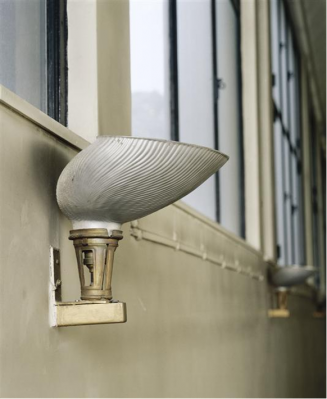Lighting

Legende
Entresol lighting
Credit
© G.Robert, 2006
At the Palais de la Porte Dorée, many lights representative of the Art Deco style were installed across the circulation areas.
In the 1920s, research on light became a major preoccupation for architects and decorators (the architect of the Palais, Albert Laprade, worked on this question a lot, especially at the Garage Marbeuf), seeking to come up with rational, comfortable lighting that could create an ambiance at the same time. The publication Lux, dedicated to lighting, was launched in 1928, and in 1933 the Salon de la Lumière was created, under the auspices of the Compagnie Parisienne de Distribution d’Électricité. The tastes of the time were for indirect lighting, which explains the fashion for mirrored vases (the light source is hidden), lamps with an upside-down cone (echoing a lotus flower, a fashionable motif since the new wave of Egyptomania following the discovery of Tutankhamun’s tomb in 1922), or wall lights, which project soft light onto the ceiling or walls. The 1931 Colonial Exposition provided the opportunity to experiment with many types of artificial lighting to illuminate the monuments at night.

Legende
Study sketch for floor lamp - Raymond Subes
Credit
© CAPA
In terms of form, two types of lighting dominate at the Palais, and they were very fashionable in the 1930s: the cone (already present in Eugène Printz’s table lamps in the Asia Salon) seen in the lamps and chandeliers on the upper ground floor; and the square for the ceiling lamps, with a very simple design, in a variety of different sizes, the biggest (one square metre) being the one in the administrative hall: 12 others are located above the staircase of honour and 13 above the North staircase.
The two wall lamps, with their metallic, shell-shaped bowls, lighting the upper part of the North staircase also draw from a model that was in fashion at the time. They are similar to two wall lights by the Bernot company, made from glass and gilded stucco and kept at the Musée d’Art Moderne de la Ville de Paris.

Legende
Ceiling lamp - Administrative hall
Credit
© Lorenzo 2012

Wall lamp, North staircase, RMN 02-009107, 2003

Legende
Floor lamp Subes, RMN 99-012407, 2003
The last elements to be admired at the Palais are the eight large lights made from forged iron with two bowls, arranged all along the French windows that illuminate the Hall of Honour. Specially created to occupy this space, where they have been since 1931, they were made by Raymond Subes (1891-1970), one of the most famous French artistic ironworkers of the Art Deco period, who also worked with the great decorators of his time, including Jacques-Émile Ruhlmann. Creator of a prolific body of work, a former student of the École Boulle and the École Nationale Supérieure des Arts Décoratifs, he notably created the stair banisters and the railings for the Île-de-France (1926), Lafayette (1930), L'Atlantique (1931) and Le Normandie (1935) ocean liners.
The shape of these lamps is reminiscent of the stylised silhouette of palm trees, with the two bowls symbolising the corolla of the leaves, while the stand with its curved forms resembles a trunk. They also echo the two table lamps designed by Eugène Printz, located in the Asia Salon.



